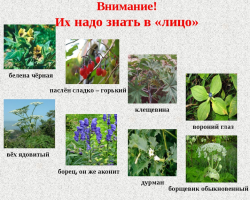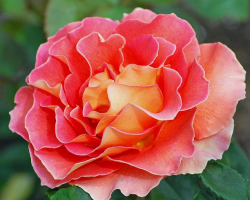How can weeds use weeds with benefit? Preparation of compost, liquid fertilizer and mulch from weeds.
Content
- Is it possible to put in compost a top of tomatoes and potatoes?
- Is it possible to put a carrion from fruit trees in compost?
- Is it possible to put in compost the leaves that you can put in compost and what is impossible?
- Compost box, compost pit or compost heap
- Using weeds for mulching beds
- Siderates plants
- How to form compost correctly
- Liquid compost of quick preparation: Instruction
- Video: DIY liquid compost
How to make compost with your own hands? Everything is very simple, you need to take weeds, the remains of plants from the garden, fallen leaves, and put them in one pile. Add the remaining foods from the kitchen there, and your correct compost will be even better.
Some beginner gardeners do not know how to make compost in the country. They pack weeds from the garden into garbage bags, and then take them to a landfill. There, some owners send corn stems in huge heavy knots. All this causes the smile of neighbors who at least once worked on Earth. Each villain knows that good compost of weeds is better than any chemical fertilizer, and corn stems are excellent fuel.
Is it possible to put in compost a top of tomatoes and potatoes?

Some people believe that the right compost with their own hands should not contain a top of tomatoes and potatoes in any case. Because these plants belong to nightshade, and contain toxic substances. Also because potatoes and tomatoes are sprayed with poisons.
We dare to reassure you, if you sprayed vegetables with permitted poisons that you bought in the store, then they do not pose any threat in compost. Such poisons, on average, break up after 20 days. The natural poison of nightshade, when they turn into compost, also ceases to act.
But people who doubt whether it is possible to put in compost the tops of tomatoes and potatoes, in our opinion, are right. And there is a reason for doubt. The compost may remain the pathogens of specific diseases of potatoes and tomatoes.
Therefore, do not use this compost for the next year for the same crops. You can use it for any other plants. For example, for cucumbers, peas, melons or shrubs. But not for tomatoes and potatoes. Make a separate small compost pile or composter for the tops of these crops.
Is it possible to put a carrion from fruit trees in compost?
Yes, you can. This is the best source material for compost. Padalitsa is rich in nutrients and minerals that accelerate the maturation of compost and allow you to create compost of the highest quality with the best characteristics of organic fertilizers. Padalitsa will attract and activate the best microorganisms and bacteria, worms, useful for soil and plants. With the proper formation of compost, neither fungi and their disputes, nor harmful bacteria, nor the stalks, nor other pests that live in the carrion will survive.
If you are still tormented by doubts about diseases and pests from the Padalitsa, then let the fruits compost for 2 years. During this time, all the pests and disputes will certainly be destroyed. Or add microbiological fertilizers for the better quality of compost. The only thing when using a carrion, keep in mind that the hard bones of the plums, apricots will rot for a very long time. But a quick result will give a Padalitsa pears and apples.
Is it possible to put in compost the leaves that you can put in compost and what is impossible?
Continuing the topic of what is possible and what can not be put in the right compost, it must be said that almost all organics can be put in it. There are not so many errors in the preparation of compost, however, in our opinion, they are.
What can not be put in compost?
- You can not put in compost paper and cardboard. Many people think that paper is organics, and send it to the composter. The paper really flows. But there is one important problem - typographic colors are very poisonous. They contain salts of heavy metals. Employees of printing houses used to even give milk for harmfulness. If this paper were clean, then it would fit for compost. But with typographic font it is better not to use it.
- Is it possible to pour into compost soapy water? The answer to this question is also not. The slop is very good for compost, but not soapy ones. PAVA ties up particles of organic matter, decorating processes in compost are disturbed, in addition, they harm worms and bacteria. Perhaps you noticed that if you pour soapy water on the ground, then there will be a visible shiny film on it, which, moreover, is impermeable for air.
- You can not put obviously sore plants with powdery mildew and rust, root rot. They must be immediately destroyed.
- In compost with caution, you need to put branches, Corn stems and other volumetric and hard parts of plants. More precisely, all this can be placed in compost, but it will be very slowly processed. If possible, grind the raw materials that you send to compost.
What can be put in compost?
- Some doubt whether to put in compost mine nuts. From the leaves of the nut is one of the best composts. It is saturated, black and resembles a fat black soil. Greak nuts do not like very many pests, for example, bear. Some gardeners say that, due to walnut compost from the site, moles even fled from the site. But they, too, are not a panacea, for example, on the May beetles, which are also considered pests, they do not act.
But in a liquid compost, which is used almost immediately, the green leaves of the nut cannot be placed. It is in the green leaves and nuts of the nut that contains a lot of natural poison. In the Caucasus, they even say that in the summer you can not sleep under a walnut, because you can not wake up. Its leaves exude poison.
- Is it possible to put in compost excrement? The life of people and animals can be placed in compost, but with small reservations. Excrements should be much smaller than plant mass in compost, an excess of nitrogen, which is a lot of fertilizers in this type of fertilizer - is also harmful to plants. You should not be afraid to become infected with cutters because of such compost, their larvae live outside the human body for no more than two weeks.
- Is it possible to put in compost dandelions and fresh they hay? Yes, any herbaceous plants are suitable for compost. You can even put pieces of turf - grass with roots and earth in compost. If you, for example, need to lay the track and this grass is superfluous.
- Bread and flour There are also good ingredients for the right compost. Yeast even accelerate decay processes in a compost heap. Orange peels, rotten apples, potato cleaning, welded berries from compote and other plant waste from the kitchen, safely send to a compost pile. Send any remnants of food on the table to compost. The best fertilizer will be made of them.

Compost box, compost pit or compost heap
Many gardeners make a compost box on their site. It should be noted that this box does not have much functional purpose. The boxes are used so that the site looks more beautiful, and food waste and weeds are not in sight.
Doing box for compost Do not try too much with your own hands. The boards knocked down with large intervals are just suitable for this purpose. The bottom of the box is not necessary. There should be open soil below, better loose. It is even better if there will be old compost at the bottom of the box for fertilizer. In general, try to make sure that the rainworms, as soon as possible, have chosen your compost pile.
You must be prepared for the fact that the board boards will become unusable very quickly, after two or three years. During construction, try to take into account that compost, about once a month, must be turned over. And it is better to provide a removable wall or make a not very high composter so that it is convenient to do. To turn the compost, it is better to use a pitchfork than a shovel to less injure rainworms that do very important work.
Compost pit It performs the function of making compost even better than a box for compost. It is cooler in it, more contact with the soil, weeds do not dry out and turn into compost faster. But not every housewife can dig a hole, still digging the earth is a heavy male robot. Some owners do not dig a compost hole, but build. It is covered with a brick or slag block, made a outlet. Above, well, such a capital compost pit needs a reliable overlap.

Compost a bunch The easiest and most common method of creating compost with your own hands. Weeds, last year's leaves and food waste are simply folded in one place. Somehow it is not necessary to cover a compost heap. Do not worry, it will not freeze even in winter. Outside, the compost heap can be covered with snow and ice, but if you shine it, you will find that it is warm inside. Compost heaps, due to the processes that go in them, is much warmer in winter than ordinary land.
Using weeds for mulching beds
Mulching is falling asleep with sawdust, hay, shell shells or any other plant material that was at hand. The purpose of this lesson is to ensure that moisture does not evaporate longer from the soil and weeds grow less. Paradoxically, weeds themselves are suitable for mulching. It is better to cut off the seeds and roots from them so that they do not take root again.
Leave weeds between the beds, and they will serve mulch for your plants. True, this method does not work for a very long time, weeds dry very quickly in the sun.

Siderates plants
Some weeds are especially useful for soil fertilizer. Sometimes whole fields are planted with Lucerne or mustard not in order to harvest, but in order to fertilize the soil. Then these plants do not mow, but simply plow with the ground. You can also try to plant the siderates on your site, and then leave them on the ground or send them to a compost pile. An example of good siderates: alfalfa, mustard, clover.
Read more about Siderates in the article How to plant it correctly and what kind of siderates in the spring, summer, autumn, in the winter: names, list
How to form compost correctly
For the correct formation of compost, several actions need to be performed:
- Put on the bottom of the heap (deepen the bottom of the heap by 20-25 cm) or the pit of the film or peat with a layer of 10 cm so that nutrients and moisture are preserved. However, keep in mind that draining excess liquids can lengthen compost ripening.
- It is better to protect the heap with boards so that the air comes, for better repletion of bookmarks. To do this, do not make a box more than a meter high and a width of more than 1.5 meters. The length of the box can be arbitrary.
- Grind the waste that you send to compost as possible, this will accelerate the composting process.
- Greens, in which there is always a lot of nitrogen or dunghill, helps to accelerate the maturation of compost.
- Make sure that brown waste and green herbs and leaves make up a proportion of 5: 1. The smell will help to understand distortions in this ratio. If it is unpleasant, add green grass. If a heap does not give signs of heat (does not soar), cold, then add brown mass.
- The compost heap should not be under the rays of the scorching sun. It is better to place it in partial shade of trees or shrubs.
- With the frequency of once a month, a bunch of turning or pierced with a fork so that its contents are saturated with oxygen, for its better burning.
- On hot days, prevent the heaps of drying out and use watering for her, making sure that moisture is not unnecessary and does not supplant the air. And when spillful or too long rains go, cover a heap with a film.
- At the end of the formation of the heap, lay the layer of the earth and the layer of straw (5-7 cm thick) and cover the heap with a film, after making holes for ventilation in it.
- You can determine the ripened compost by appearance (it is crumbly, dark brown) and the smell that resembles the smell of the overwhelmed land of the forest.
Liquid compost of quick preparation: Instruction
DIY liquid compost is done in just 1-2 weeks. The cooking time depends on how warm and sunny weather is on the street. The raw materials for the preparation of fertilizer are weeds collected from the same site that will be fenced. Therefore, the fertilizer is absolutely free.
To make a liquid compost with your own hands, you will need an iron barrel, and preferably a barrel or a bucket of plastic. If possible, give preference to plastic. Because it does not react so much with the liquid inside, like metal. Immediately you need to make sure that you have a cover for your container, or a piece of film with holes that can be pulled from above.
Take weed grass from your site. Separate those parts on which there are seeds, and throw them away, or take them to a regular compost pile.
In liquid compost, weeds are not needed. Compost is prepared quickly, these seeds will not be processed in any way, and will inevitably rise on the beds.

Take freshly fabricated weeds from the site and chop them. What you can tear with your hands is better to tear with your hands. What is difficult to grind can be cut a secateur. If the earth remains in the roots of plants, do not remove it. It has many microorganisms that will accelerate the process of fermentation of liquid compost.
In order to accelerate the process, it is useful to add a slightly ready -made compost from last year to the container.
The container with compost should be attributed to the warmest and most sunny place. But it is better that this place is far from the house. Because the smell when fermentation of the grass is very caustic and specific. Even neighbors in the site can feel it.
The smell can be driven into the skin, when working with compost, so it is better to put on gloves.
- A bucket with compost needs to be covered loosely with a lid or film. Make a few holes in the film so that the gases that occur during fermentation can evaporate.
- Grass for compost use any. Sedding, dandelions, wormwood, yellow weed, which is called a cash, and very many other plants are suitable.
- A liter of finished compost should be mixed with a bucket of water. After that, pour it under the bushes of cultivated plants.

On our site there are many other interesting articles about gardening:
- Weeds in the garden: varieties, names, methods of struggle
- What plants cannot be fed with ash?
- Effective methods of weed combat.
- 10 useful tips to the gardener.
- Mustard in the role of Siderat.
- Lazy beds that do not need to dig.
- How to clean and store carrots in winter.







